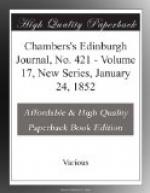The ivory miniature tablets so much in use, and which are so invaluable to the artist from the exquisitely delicate texture of the material, are now produced by means of a very beautiful and highly interesting chemical process. Phosphoric acid of the usual specific gravity renders ivory soft and nearly plastic. The plates are cut from the circumference of the tusk, somewhat after the manner of paring a cucumber, and then softened by means of the acid. When washed with water, pressed, and dried, the ivory regains its former consistency, and even its microscopic structure is not affected by the process. Plates thirty inches square have been formed in this way, and a great reduction in price has thus been effected. Painting on ivory, we may add, was practised among the ancients.
Mr M’Culloch and other statistical writers predict the speedy extinction of the elephant, from the enormous consumption of its teeth; and curious calculations of the number of these animals annually extirpated to supply the English market alone are now getting somewhat popular. For example: ’in 1827 the customs-duty on ivory (20s. per cwt.—since reduced to 1s.) amounted to L.3257. The average weight of the elephant’s tusk is 60 lbs.; and therefore 3040 elephants have been killed to supply this quantity of ivory.’ But these calculations are in many respects quite fallacious. In the first place, the average weight of our imported tusks is not 60 lbs.: we have the authority of one of the first ivory-merchants in London for stating that 20 lbs. will be a much closer approximation. This at once involves a threefold ratio of destruction. In place of 3040, we should have the terrible slaughter of 9120 elephants for one year’s consumption of ivory in England! This, however, is not the case. In these calculations the immense masses of fossil ivory we have alluded to are obviously overlooked, and the equally immense quantities of broken teeth which are disinterred from the deserts of Arabia, or the jungles of Central Africa. The truth is, we have good reason to know, that a very large proportion of the commercial supply of Europe is sustained from the almost inexhaustible store of these descriptions of ivory.
Nevertheless, it is indisputable that the insatiable demands of modern commerce will inevitably lead to the ultimate extermination of this noble animal. His venerable career is ignominiously brought to an end merely for the sake of the two teeth he carries in his mouth; which are very likely destined to be cut into rings to assist the infant Anglo-Saxons in cutting their teeth, or partly made into jelly to satisfy the tastes and appetites of a London alderman. We cannot reasonably hope for a new suspension of the traffic: indeed we can only look for its extension. The luxurious tastes of man are inimical to the existence of the elephant. From time immemorial, the war of extermination has existed. His rightful domain—in the plain or the wilderness,




